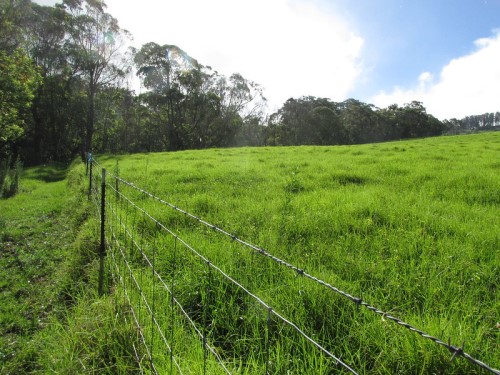Kikuyu grass, Kikuyugrass (Cenchrus clandestinus)
 Hawai‘i-Pacific Weed Risk Assessment Score: 18 (High Risk). Visit Plant Pono for more information.
Hawai‘i-Pacific Weed Risk Assessment Score: 18 (High Risk). Visit Plant Pono for more information.
Weed Fire Risk Score = 0.59 (This species is likely a high fire risk in Hawai’i); Visit Pacific Fire Exchange Weed Risk Assessments for more information
Regulatory Status: Federal Noxious Weed
Prevention and Control Category: N/A
Description
- Perennial, valued forage, forms thick and tight turf. Without grazing or mowing, shoots and leaves reach 2 ft tall. Shoots are thick. Leaves are light green. Inflorescences 2 tiny spikes concealed in axils, hence the species name. Rarely produces seed except at high elevations where the kikuyu grass has been mowed. Primary mode of spread is vegetative.
- Originally from the mountains of East Africa. Introduced throughout Malesia: Malay Pen. (Pahang: Cameron Highlands), Sumatra (Palembang), Java (Cibeureum), Sabah (Pinosok Plateau), Philippines (Luzon), Papua New Guinea (Enga, W Highlands Prov.), and elsewhere in the tropics.
Impacts
- In unmanaged ecosystems, kikuyu spreads aggressively through runners which can smother other plants, making it hard for native or desired plants to grow
- Can carry fire during periods of drought, but otherwise burns slowly, and generally retards fire.
- Susceptible to damage from two-lined spittlebug, which may open up large areas to invasion by other weeds.
- Allelopathic
Uses
- In managed pastures, the grass is highly palatable to cattle and other grazing animals.
- Can prevent the establishment of woody weeds and other undesirable vegetation.
- Can act as a fire break for adjacent native ecosystems or population centers
- Readily controlled with low concentrations of herbicide.
Distribution
Naturalized in dry to mesic forest, open sites in wet forest, and pastures, 0-1,220 m, on all the main Hawaiian islands except Niʻihau and Kaho‘olawe.